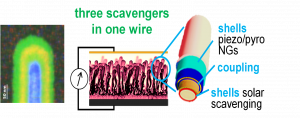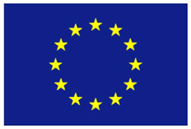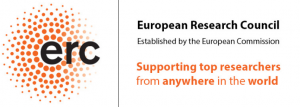Projects financed by European Union
|
|
Advancing supercapacitors with plasma-designed multifunctional hybrid materialsM-ERA Net COFUND (PCI2024-153451) PI: Juan Ramón Sánchez Valencia (Jun-2024/Jun-2027) |
Read more …
…
|
|
Sustainable Smart De-Icing by Surface Engineering of Acoustic Waves (SOUNDofICE)H2020-FET OPEN (Grant agreement 899352) PI: Ana I Borrás (Nov-2020/Apr-2025) |
Read more …
Icing on surfaces is commonplace in nature and industry and too often causes catastrophic events. SOUNDofICE ultimate goal is to overcome costly and environmentally harmful de-icing methods with a pioneering strategy based on the surface engineering of MHz Acoustic Waves for a smart and sustainable removal of ice. This technology encompasses the autonomous detection and low-energy-consuming removal of accreted ice on any material and geometry. For the first time, both detection and de-icing will share the same operating principle. The visionary research program covers the modeling of surface wave atom excitation of ice aggregates, integration of acoustic transducers on large areas, and the development of surface engineering solutions to stack micron-size interdigitated electrodes together with different layers providing efficient wave propagation, anti-icing capacity, and aging resistance. We will demonstrate that this de-icing strategy surpasses existing methods in performance, multifunctionality, and capacity of integration on industrially relevant substrates as validated with proof of concept devices suited for the aeronautic and wind power industries. SOUNDofICE high-risks will be confronted by a strongly interdisciplinary team from five academic centers covering both the fundamental and applied aspects. Two SMEs with first-hand experience in icing will be in charge of testing this technology and its future transfer to key EU players in aeronautics, renewable energy, and household appliances. An Advisory Board incorporating relevant companies will contribute to effective dissemination and benchmarking. The flexibility of the R&D plan, multidisciplinarity, and assistance of the AdB guarantee the success of this proposal, bringing up a unique opportunity for young academia leaders and SMEs from five different countries to strengthen the EU position on a high fundamental and technological impact field, just on the moment when the climate issues are of maxima importance.
|
|
Three dimensional Nanoscale design for the all-in-one solution to environmental environmental multisource energy scavenging (3DScavengers)ERC-2019-STG (Grant agreement 851929) PI: Ana I Borrás (Mar-2020/Feb-2025) |
Read more …
Imagine a technology for powering your smart devices by recovering energy from lights in your office, the random movements of your body while reading these lines or from small changes in temperature when you breathe or go out for a walk. This very technology will provide energy for wireless sensor networks monitoring the air in your city or the structural stability of buildings and large constructions remotely and sustainably, avoiding battery recharging or even replacing them. These are the challenges in micro energy harvesting from (local) ambient sources.

Kinetic, thermal and solar energies are ubiquitous at our surroundings under diverse forms, but their relatively low intensity and intermittent availability limit their potential recovery by microscale devices. These restrictions call for multi-source energy harvesters working under two principles: 1) combining different single-source harvesters in one device, or 2) using multifunctional materials capable of simultaneously converting various energy sources into electricity. In 1), efficiency per unit volume can decrease compared to the individual counterparts; in 2), materials as semiconductors, polymeric and oxide ferroelectrics and hybrid perovskites may act as multisource harvesters but huge advances are required to optimize their functionalities and sustainable fabrication at large scale.
I propose to fill the gap between these approaches offering an all-in-one solution to multisource energy scavenging, based on the nanoscale design of multifunctional three-dimensional materials. The demonstration of an industrially scalable one-reactor plasma/vacuum method will be crucial to integrate hybrid-scavenging components and to provide 3DScavengers materials with tailored microstructure-enhanced performance.
My ultimate goal is to build nanoarchitectures for simultaneous and enhanced individual scavenging applying photovoltaic, piezo- and pyro-electric effects, minimizing the environmental cost of their synthesis.
 |
Super-IcePhobic surfaces to prevent ice formation on aircraft (PHOBIC2ICE)
H2020-TRANSPORT/0149 PI: Agustín R. González-Elipe (Feb-2016/Jan-2019) |
Read more …
The accretion of ice represents a severe problem for aircraft, as the presence of even a scarcely visible layer can severely limit the function of wings, propellers, windshields, antennas, vents, intakes and cowlings. PHOBIC2ICE Project aims at developing technologies and predictive simulation tools for avoiding or mitigating this phenomenon.
PHOBIC2ICE project, by applying an innovative approach to simulation and modelling, will enable the design and fabrication of icephobic surfaces with improved functionalities. Several types of polymeric, metallic and hybrid coatings using different deposition methods will be developed. Laser treated and anodized surfaces will be prepared. Consequently, the Project focuses on collecting fundamental knowledge of phenomena associated with icephobicity issues. This knowledge will give better understanding of the ice accretion process on different coatings and modified surfaces. Certified research infrastructure (ice wind tunnel) and flight tests planned will aid in developing comprehensive solutions to address ice formation issue and will raise the Project’s innovation level.
The proposed solution will be environment-friendly, will contribute to the reduction of energy consumption, and will help eliminate the need for frequent on-ground de-icing procedures. This in turn will contribute to the reduction of cost, pollution and flight delay.
| Financial source: European Union
Code: H2020-TRANSPORT/0149 Acronym: PHOBIC2ICE |
Research team: Ana Borrás, Victor Rico. |
 |
A full plasma and vacuum integrated process for the synthesis of high efficiency planar and 1D conformal perovskite solar cells (PlasmaPerovSol)H2020-MSCA-IF-2014 (Project ID: 661480) PI: Juan Ramón Sánchez Valencia (Jan-2016/Dec-2017) |
Read more …
Photovoltaic or solar cells (SC) devices –that transform light into electricity- have been extensively studied in the last decades since they represent a promising way to exploit the sun energy. Currently, perovskite-based solar cells(SC) are receiving increasing attention due to their low cost and high efficiency. They are very promising as an alternative for the existing ones, but still need to advance to reach higher efficiency and durability and require synthesis methods compatible with the industrial production of CMOS devices at wafer scale. These recent SC are mostly fabricated via wet methods in planar architecture. Inherent to the nature of the wet approaches, usually appear several drawbacks as contaminations and chemical reactions on the interfaces that might result deterioration of the SC performance.
PlasmaPerovSol main objective is the fabrication of a complete perovskite solar cell device by a full plasma and vacuum integrated process carried out under the premises of the “one reactor concept”. Thus, the different components of the solar cell will be deposited sequentially within a vacuum reactor avoiding exposition of the materials and interfaces to air or solvents. The technology developed by the hosting group combine vacuum deposition assisted by plasma that permits the fabrication of conformal layers over a large variety of templates. This approach is also proposed here to fabricate conformal multilayers over 1D scaffold that will push the advantages of one-dimensional SC. Plasma and vacuum processes present as advantage the high purity and stoichiometric control on the deposition within an ample range of materials compositions. The synthesis approach is compatible with large scale industrial production and allows the fabrication of SC on processable and flexible substrates. At the same time, the low temperatures used make the approach compatible with current CMOS technology and by using masks permits their integration on preformed devices.
|
Financial source: Acronym: PlasmaPerovSol Project ID: 661480 |
Research Supervisor: Research group: University Pablo de Olavide: Juan Antonio Anta, Jesús Idígoras |
FURTHER INFORMATION
 |
Innovative SOFC Architecture based on Triode Operation (T-CELL) FCH-JU-2011-1 PI: Agustín R. González-Elipe (Sept-2012/Aug-2015) |
Read more …
The development of Solid Oxide Fuel Cells (SOFCs) operating on hydrocarbon fuels (natural gas, biofuel,LPG) is the key to their short to medium term broad commercialization. The development of direct HC SOFCs still meets lot of challenges and problems arising from the fact that the anode materials operate under severe conditions leading to low activity towards reforming and oxidation reactions, fast deactivation due to carbon formation and instability due to the presence of sulphur compounds. Although research on these issues is intensive, no major technological breakthroughs have been so far with respect to robust operation, sufficient lifetime and competitive cost. T-CELL proposes a novel electrochemical approach aiming at tackling these problems by a comprehensive effort to define, explore, characterize, develop and realize a radically new triode approach to SOFC technology means of an integrated approach based both on materials development and on the deployment of an innovative cell design that permits the effective control of electrocatalytic activity under steam or dry reforming conditions. The novelty of the proposed work lies in the pioneering effort to apply Ni-modified materials electrodes of proven advanced tolerance, as anodic electrodes in SOFCs and in the exploitation of our novel triode SOFC concept which introduces a new controllable variable into fuel cell operation. In order to provide a proof of concept of the stackability of triode cells, a triode SOFC stack consisting of at least 4 repeating units will be developed and its performance will be evaluated under methane and steam co-feed, in presence of a small concentration of sulphur compound.
| Financial source: Europen Union Code: FCH-JU-2011-1 |
Research group @ICMS: |
 |
Environmentally friendly processing of ceramics and glass (CERAMGLASS) LIFE11 ENV/ES/560 PI: Xerman de la Fuente (ICMA) (Jan-2011/Dec-2014) |
Read more …
The general objective of the ‘CERAMGLASS’ project is to reduce the environment impact of thermal treatment of ceramics by the successful application of an innovative laser-furnace technology on planar ceramics and glass. The project plans to construct a pilot plant based on the innovative combination of a continuous furnace and a scanning laser. It aims at demonstrating a considerable reduction in energy consumption and the industrial scalability of the process. The project primarily aims at showing that it is feasible to produce robust ceramic tile of only 4 mm thick. This would represent a 50% reduction in tile thickness, with consequent reduction in consumption of raw source materials. The project will adapt decoration compositions with more environmentally friendly materials by using the laser processing. Specifically it will adapt screen printing decorations to third-fire products with lustre and metallic effects and decoration inks for planar glass. The replacement of toxic starting materials will allow a minimisation of CO2 and other gas emissions, toxic residues and a reduction of the energy consumption of the process.
| Financial source: European Union Code: LIFE11 ENV/ES/560 |
Research group @ICMS: |





